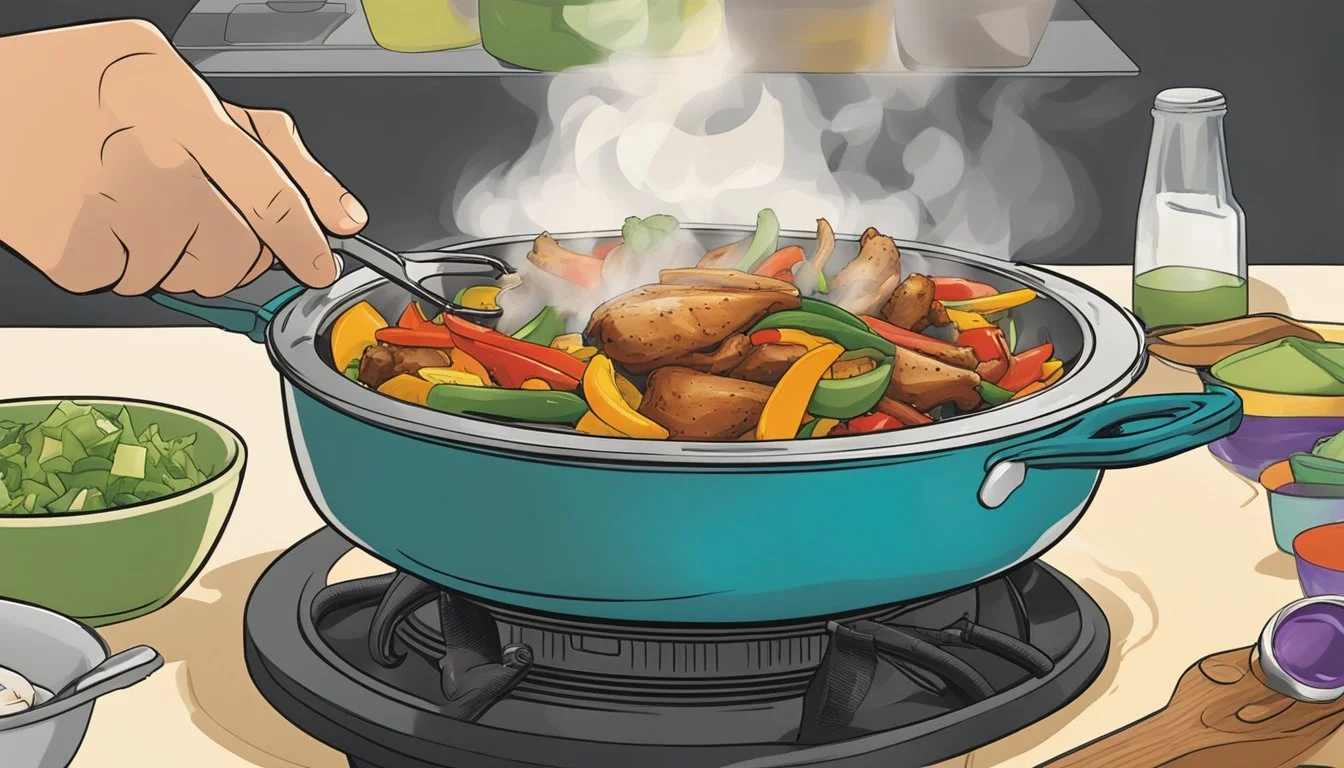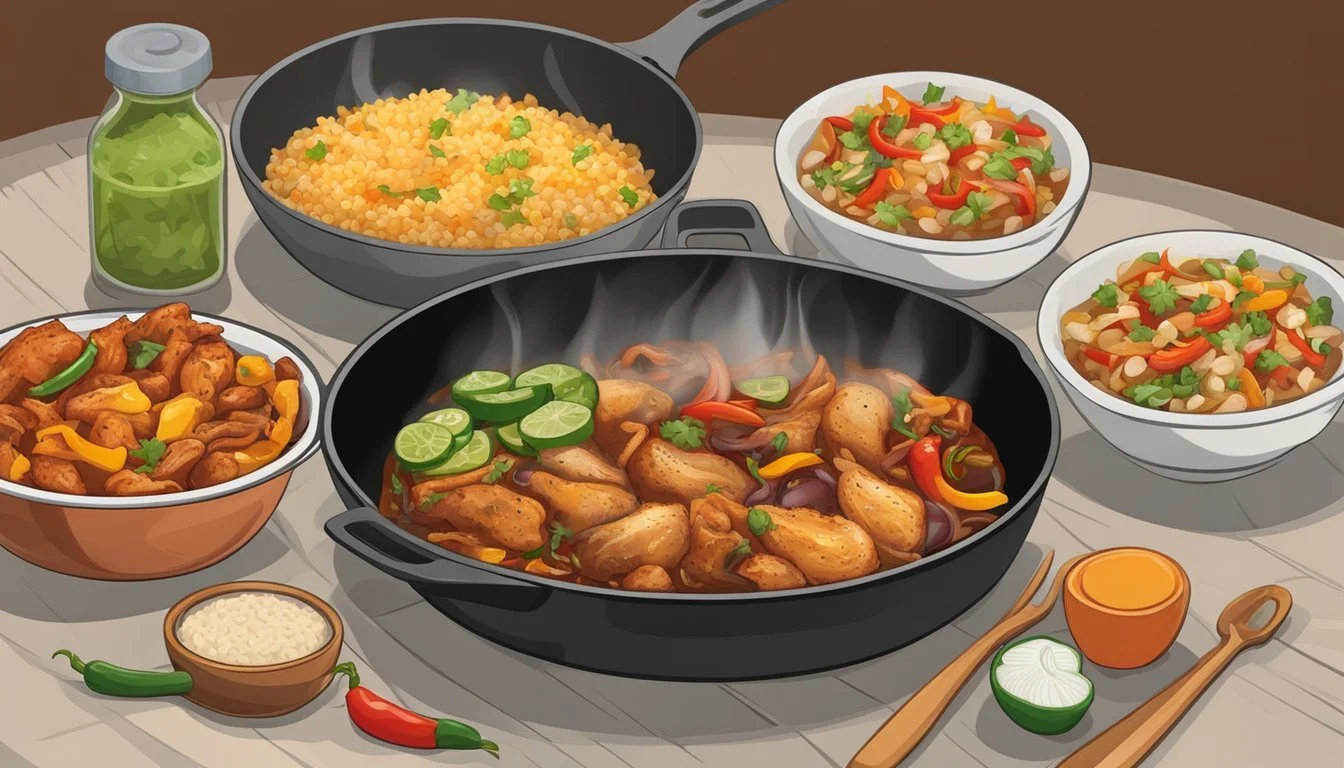How to Reheat Chicken Fajita Bowls
Simple and Effective Methods
Reheating chicken fajita bowls can be done effortlessly while maintaining their delicious flavors and textures. One efficient way to reheat your fajita bowls is by using a skillet on the stovetop. Place the skillet over medium heat, add a bit of olive oil, and gently reheat the chicken, bell peppers, and onions, tossing them occasionally to avoid burning. This method ensures the chicken remains juicy, and the vegetables retain their crispiness.
Another effective approach is using the oven, especially if you want to reheat a larger portion. Preheat the oven to 356°F (180°C), arrange the chicken fajita mix on an oven dish, cover it with aluminum foil to prevent drying out, and heat them for about 30 minutes. This technique evenly warms the meal, preserving both the flavor and texture.
Microwaving can be a quick and convenient option for those in a hurry. Transfer your chicken fajita bowl to a microwave-safe dish, cover it with a damp paper towel, and microwave it for 2-3 minutes. Covering the dish keeps the moisture in, preventing the chicken from becoming dry. These methods ensure your reheated chicken fajita bowls remain as tasty and satisfying as when they were freshly cooked.
Understanding Chicken Fajita Bowls
Chicken fajita bowls are a flavorful and nutritious meal option. They typically contain chicken, rice, vegetables, and various toppings, offering a balanced mix of protein, fiber, and essential nutrients.
Key Components of a Chicken Fajita Bowl
A chicken fajita bowl is built around a few key elements. Chicken is often marinated in a blend of spices such as cumin and chili powder to infuse flavor before grilling or sautéing. Rice serves as the base, providing a hearty and filling component.
Vegetables like bell peppers and onions are sautéed until tender, adding both texture and taste. Beans are another staple, offering additional protein and fiber. Common toppings include salsa, guacamole, sour cream, and cheese, which enhance both flavor and richness.
Nutritional Value and Health Benefits
Chicken fajita bowls are a nutritious choice due to their balanced ingredients. The chicken provides lean protein, essential for muscle maintenance and repair. Rice offers carbohydrates for energy, while vegetables contribute vitamins and minerals.
Beans add more protein and fiber, which aids digestion and keeps you feeling full. Peppers and onions are rich in vitamins A and C, supporting immune health. Toppings like salsa are low in calories but high in antioxidants, while guacamole adds healthy fats. Using sour cream and cheese in moderation can provide calcium and additional flavor.
Preparing Chicken Fajita Bowls
Chicken fajita bowls are a rich and satisfying meal, combining seasoned chicken with fresh vegetables and flavorful seasonings. Here’s how to prepare delicious chicken fajita bowls with both homemade and store-bought ingredients, the best types of chicken, ideal vegetables, and the perfect seasoning mix.
Homemade vs. Store-Bought Ingredients
Using homemade ingredients allows for greater control over flavors and dietary preferences. Homemade fajita seasoning can be customized to include specific spices such as cumin, chili powder, paprika, garlic powder, and salt. Mixing these spices ensures balanced flavors and reduced sodium.
Store-bought ingredients, on the other hand, offer convenience. Pre-made fajita seasoning mixes and pre-chopped vegetables save time. Look for high-quality, low-sodium options to maintain health benefits. Whether choosing homemade or store-bought, balance freshness with convenience.
Choosing the Right Chicken
Chicken breast and thighs are popular choices for fajita bowls. Chicken breast offers a leaner option, while chicken thighs provide richer flavor due to their higher fat content.
Both need proper seasoning and cooking to be tender and flavorful. Marinating chicken in lime juice, olive oil, garlic powder, and fajita seasoning enhances taste and tenderness. Cooking can be done on a skillet or grill, ensuring even, fully cooked pieces. Choose thighs for juicier, more flavorful meat, or breasts for a healthier, leaner alternative.
Vegetable Selection and Preparation
Vegetable variety and preparation play a significant role in flavor and texture. Bell peppers and red onions are classic choices, offering sweetness and crunch. Important additions include black beans, corn, and cilantro, adding protein, texture, and freshness.
Dice vegetables into equal sizes for uniform cooking. Toss them in olive oil and fajita seasoning before sautéing or grilling. This enhances flavors and ensures a perfect balance with the seasoned chicken. Freshness is crucial, so select vibrant, firm vegetables to keep the dish lively and appetizing.
Seasoning Mixes and Flavors
A well-rounded fajita seasoning mix typically includes cumin, chili powder, paprika, garlic powder, and salt. A homemade fajita seasoning allows for adjustments in spice levels and flavor intensity.
To make the seasoning, combine 1 tsp cumin, 1 tsp chili powder, ½ tsp paprika, ½ tsp garlic powder, and ½ tsp salt. Mix thoroughly.
When marinating the chicken, add lime juice to enhance flavor and tenderize. Cooking the chicken in its marinade ensures the uptaken spices permeate the meat. Balancing flavors with homemade seasoning creates a personalized and delicious chicken fajita bowl.
Storing and Preserving Chicken Fajitas
Proper storage of chicken fajitas ensures they remain safe to eat and retain their flavor and texture. Keeping leftovers in the right conditions will also help in avoiding bacterial growth.
Optimal Storage Techniques
For optimal storage, place leftover fajitas in airtight containers. This method prevents exposure to air, which can lead to spoilage. Before sealing the container, make sure the fajitas are cooled to room temperature.
Refrigerate the fajitas promptly, storing them in the refrigerator at or below 40°F (4°C). Use aluminum foil to cover the container if it doesn’t have a lid; this helps in preserving moisture and preventing flavor absorption from other foods in the fridge.
Leftover fajitas should be consumed within 3-4 days to ensure safety and maintain quality.
Freezing and Thawing Instructions
For longer storage, freezing is a viable option. Pack the chicken fajitas in freezer-safe airtight containers or heavy-duty freezer bags. Remove as much air as possible before sealing to prevent freezer burn. Label the containers with the date to keep track of how long they’ve been stored.
To thaw frozen fajitas, transfer them to the refrigerator 24 hours before you plan to reheat them. This gradual thawing method helps retain the texture and flavor. For quicker thawing, use the defrost setting on your microwave, but be sure to follow it immediately with proper reheating to ensure safety.
Using these techniques ensures that your chicken fajitas retain their taste and texture whether stored for a few days in the fridge or several months in the freezer.
Safe Reheating Practices
Properly reheating chicken fajita bowls ensures safety and optimal flavor. Key points include understanding the different methods available and using them to avoid overcooking or undercooking your meal.
Reheating Principles
To maintain safety and quality, reheating should bring the chicken to an internal temperature of 165°F (74°C). Always use appropriate cookware, like a microwave-safe plate or an oven dish covered with aluminum foil. Stirring or tossing the food helps heat it evenly, avoiding cold spots that could harbor bacteria.
Microwave Method
Using a microwave is the quickest way to reheat chicken fajita bowls. Place the bowl contents on a microwave-safe plate. Cover with a microwave-safe lid or damp paper towel to retain moisture.
Heat on medium power for 2-3 minutes, stirring halfway to ensure even reheating. Check the temperature of the chicken; if it hasn’t reached 165°F, continue heating in 30-second intervals.
Oven and Toaster Oven Techniques
Preheat the oven or toaster oven to 350°F (180°C). Transfer your chicken fajita bowl contents to an oven dish. Cover the dish with aluminum foil to prevent drying out.
Reheat for about 20-30 minutes. Stir the fajitas halfway through to promote even reheating. Ensure the chicken reaches the safe temperature of 165°F before serving. Ovens take longer, but they can enhance flavors and maintain texture.
Stovetop Reheating
For stovetop reheating, add 1-2 tablespoons of vegetable oil to a pan. Heat the oil over medium heat. Once the oil is hot, add the chicken fajita mixture.
Toss it around the pan for 3-4 minutes, stirring constantly. This method enhances the flavors and keeps the fajita mix crispy. Make sure all parts reach 165°F to ensure it’s safe to eat.
Air Fryer Usage
Preheat the air fryer to 350°F (180°C). Place the chicken fajita mixture in the air fryer's basket, spreading it out in a single layer. This ensures even reheating.
Cook for 4-6 minutes, checking and shaking the basket halfway through. This method adds a nice crispiness to the fajitas. Ensure the chicken pieces are heated thoroughly and reach the safety threshold of 165°F.
Enhancing Your Fajita Bowl Experience
Incorporating a variety of toppings and side dishes can take your chicken fajita bowl from good to great. These additions can amplify the flavor and texture, adding a more satisfying and complete experience.
Topping Options and Variations
Adding diverse toppings can significantly enhance the flavor profile of your chicken fajita bowl. Shredded cheese like cheddar or Monterey Jack can add a rich, creamy texture. Sour cream provides a cooling effect that balances the dish's heat.
Guacamole or sliced avocado brings a creamy richness, while salsa or pico de gallo offers fresh, zesty flavors. A sprinkle of cilantro adds a burst of freshness, and a squeeze of lime wedges can brighten up the entire bowl.
For those who enjoy a bit of crunch, tortilla chips can be crumbled on top. If you like spice, consider adding pickled jalapeños or hot sauce to kick it up a notch. These toppings allow for numerous variations, making each bowl unique and customizable to your taste.
Accompaniments and Side Dishes
Complementary side dishes can round out your meal, making it more filling and balanced. Flour tortillas served on the side can transform your fajita bowl into a DIY wrap, adding versatility to your dining experience. Tortilla chips are excellent for scooping up any remaining toppings and adding an enjoyable crunch.
Consider serving the fajita bowl with Mexican rice or refried beans for added substance. Black beans and corn salad also work well, providing additional flavors and textures that complement the fajita mix. Lighter options like a mixed green salad or coleslaw can provide a refreshing contrast.
Including a variety of accompaniments enhances the overall meal, ensuring you have a well-rounded and enjoyable eating experience.
Creative Leftovers
Repurposing leftover chicken fajitas can lead to exciting, delicious meals. Utilize these simple, innovative approaches to reduce waste and enjoy your food in new ways.
Innovative Recipes Using Leftover Chicken Fajitas
Leftover chicken fajitas can be converted into various chicken recipes, bringing fresh flavors to your table. Quesadillas are a popular choice; simply spread the fajita mix between two tortillas with cheese and grill until crispy.
For a twist, use the leftover mix to fill soft tacos. Add diced tomatoes, mushrooms, and a little bit of shredded lettuce for a fresh lunch.
You can also try making a rice bowl recipe by placing the leftover chicken fajitas over a bed of cauliflower rice, quinoa, or traditional rice.
Transforming Chicken Fajita Bowls into New Meals
Transform your chicken fajita bowls into brand-new meals with some creativity. Stir the chicken and veggies into scrambled eggs for a savory breakfast frittata. This adds a boost of protein and some morning excitement to your meal prep.
Alternatively, create a hearty plate of nachos. Layer tortilla chips on a baking sheet, top with fajita ingredients, sprinkle with cheese, and bake until cheese melts.
Lastly, consider making stuffed sweet potatoes. Scoop out the inside of a cooked sweet potato, combine it with the fajita mix, then place it back into the potato shell. Top with some grated cheese and bake until the cheese is bubbly.
These strategies ensure your leftover chicken fajitas never go to waste.




